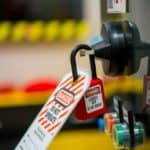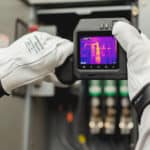Lockout/Tagout Training
Control of Hazardous Energy - LOTO (1910.147 standard)
Partner with our safety leaders to provide training that ensures your LOTO program delivers its intended compliance and injury prevention goals.
According to OSHA’s “Top 10 most frequently cited standards” report for FY 2021, LOTO ranked fifth most frequently cited standard. Empower your people with the skills and knowledge to do their job safely and in compliance with regulatory standards.
Lockout Tagout Training Course
- LOTO Authorized – Affected Person
- Electrical Safe Work Practices – NFPA 70E 2024
Whether you are developing a new LOTO training program or need support assessing or updating your current one, we can assist with energy control procedures, employee training, periodic audits, and annual reviews.
Book Your Training Today!
LOTO Authorized - Affected Person
Training duration: 1 day
Energy sources including electrical, mechanical, chemical, thermal, and others can be hazardous to employees, contractors, and the overall performance of your energized assets. Workers performing services or maintenance on machinery and equipment may be exposed to injuries from the unexpected energization, startup of the machinery or equipment, or release of stored energy in the equipment.
Lockout/Tagout standards require the adoption and implementation of practices and procedures to shut down equipment, isolate it from its energy source(s), and prevent the release of potentially hazardous energy while maintenance and servicing activities are being performed.
Hazard risk assessment
- Arc flash hazard assessment
- Incident energy analysis
- Arc flash boundaries
- Approach boundaries for shock protection
- Clearance distances
- Equipment labeling
Common LOTO devices
- Breaker locks
- Switch lock
- Plug and cord LOTO
- Wheel valve cover
- Ball valve cover
- Hasp
- Tags and tagout
- Checks on learning
Terminology and equipment
- Lockout device
- Energy isolating device
- Authorized employee
- Affected employee
- Checks on learning
Elements of a LOTO program
- 4 primary elements
- General LOTO procedures
- LOTO exceptions
- Transfer of LOTO responsibility
- Emergency release of LOTO
Written energy control procedures
- Equipment specific
- When written procedures are required
- Procedure examples
- Alternative protective measures
- Alternative protective measures example
Common electrical LOTO
- Common electrical devices
- Electrical PPE
- Common LOTO examples
Common pneumatic LOTO
- Common sources of pneumatic energy
- Common pneumatic LOTO examples
Common water and chemical LOTO
- Common sources of water and chemical energy
- Common pneumatic LOTO examples
Common gravitational LOTO
- Common sources of gravitational energy
- Common gravitational LOTO examples
Common hydraulic LOTO
- Common sources of hydraulic energy
- Common hydraulic LOTO examples
What is LOTO and who makes the rules?
- What is lockout/tagout?
- What do LOTO devices do?
- What is hazardous energy?
- What is the difference between a hazard and a risk?
- What is a job hazard analysis?
- The hierarchy of controls
- What are your PPE requirements
- OSHA CFR 1910. 147
- NFPA 70E
- Checks on learning
Periodic inspections
- Annual verification of procedures
- Elements of verification process
LOTO injuries
- 3 examples from OSHA file
Electrical Safe Work Practices – NFPA 70E 2024
Training duration: 1 day
This fast-paced class is designed for all personnel working on, around, or near any electrically energized equipment. Topics discussed include electrical hazards, the safe installation of electrical equipment, and proper electrical work practices and procedures.
Key takeaways from this training:
- Differences between the 2021 and 2024 NFPA 70E standard editions
- Increased safety awareness
- Understanding of the minimum requirements of the OSHA standards and their application in the workplace
- The ability to spot hazards, avoid accidents, and prevent costly fines
- Injury prevention and life-saving knowledge
- The critical relationship between the NFPA 70E and NFPA 70B standards
Standards for electrical safety
- OSHA CFR 1910.331-335
- NFPA 70B & NFPA 70E
- Workplace safety programs
Personal protective equipment
- Arc rated clothing
- PPE Categories
- Voltage-rated gloves and tools
- Selecting PPE, incident energy vs. 70E tables
Electrical fundamentals
- Understanding electricity
- Conductors/Insulators
- Shock safe and unsafe current values
Work involving electrical hazards
- Justification
- Permits
- Exemptions
Risk assessment
- Assessment procedure
- Human error
- Likelihood of occurrence
- Hierarchy of risk control methods
- NFPA 70E hazards
- Approach boundaries for electric shock protection
- Limited
- Restricted
- Arc flash boundary
- Clearance distances
- Labeling
Insulating and other protective methods
- Rubber insulating gloves
- Insulated tools
- Barricades/Attendants
- Conductive articles
Outside service personnel
- Host employer
- Contractor employer
Reducing electrical hazards
- Circuit breakers
- Fuses
- Grounding
- Cords
- GFCI
Meter safety
- Selection and use
- Types
- Category rating
Energy control program
- Lockout/Tagout
- Training
- Auditing
- Stored energy
Battery safety
- Article 320 & Annex F
- Damaged lithium batteries
- Capacitors
NIOSH case studies
- Fatality assessment
- Attitudes, emotions
The SEAM Group Difference
Collaboration and Partnership Defined
More than a vendor, SEAM Group functions as a strategic advisor to meet you where you are and take you where you need to be. We uncover quick wins, while also developing and managing long-term programs to help you exceed ongoing safety, reliability, and maintenance goals.
Related Content
Taking a Deep Dive into the World of LOTO
Article Originally Featured in Occupational Health & Safety (OH&S) Author: Bret Bevis, SEAM Group Program Manager – Infrared & ViewPoint Procedures must keep pace with
NFPA 70E® Training Considerations to Move Electrical Workplace Safety Forward
To protect employees from electrical-related injuries, the National Fire Protection Association (NFPA) has developed the Standard for Electrical Safety in the Workplace® known as NFPA
Developing a Safer, More Effective Lockout/Tagout Program
Energy sources such as electricity, chemical, pneumatic, hydraulic, mechanical and many others can be hazardous to workers. During the servicing and maintenance of machines and





